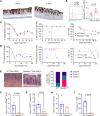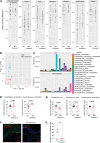Intestinal epithelial Ceacam1 deficiency prevents steroid-refractory acute gut graft-versus-host disease
- PMID: 40923321
- PMCID: PMC12487693
- DOI: 10.1172/jci.insight.186984
Intestinal epithelial Ceacam1 deficiency prevents steroid-refractory acute gut graft-versus-host disease
Abstract
Steroid-refractory gut acute graft-versus-host disease (SR-Gut-aGVHD) is the major cause of nonrelapse death after allogeneic hematopoietic cell transplantation. High numbers of donor-type IL-22+ T cells, IL-22-dependent dysbiosis, and loss of antiinflammatory CX3CR1hi mononuclear phagocytes (MNPs) play critical roles in SR-Gut-aGVHD pathogenesis. CEACAM1 on intestinal epithelial cells (IECs) is proposed to regulate bacterial translocation and subsequent immune responses in the intestine. Here, with imaging mass cytometry (IMC), combined scRNA-Seq with ATAC-Seq, and high-dimensional flow cytometry analysis, we show that CEACAM1 expression was enhanced on IECs in murine and human SR-Gut-aGVHD. Ceacam1 deficiency on host IECs effectively prevented SR-Gut-aGVHD in murine models. Ceacam1 deficiency on IECs resulted in (i) higher numbers of IL-22+IL-10+Foxp3+CD4+ peripheral Tregs (pTregs) and lower numbers of conventional IL-22+CD4+ T (Tcon), Th/Tc1, and Th17 cells in the intestine; (ii) higher prevalence of beneficial commensal bacteria that augment colonic pTreg expansion, with lower prevalence of pathogenic bacteria; and (iii) higher numbers of antiinflammatory CD103-CX3CR1hi MNPs that produce indoleamine 2,3-dioxygenase (IDO) and IL-10, with lower numbers of proinflammatory CD103+CX3CR1lo MNPs that produce IL-6. Thus, specifically targeting IEC CEACAM1 represents a promising approach for prevention of SR-Gut-aGVHD.
Keywords: Bone marrow transplantation; Cellular immune response; Hematology; Immunology; Mouse models; Transplantation.
Conflict of interest statement
Figures









References
MeSH terms
Substances
Grants and funding
LinkOut - more resources
Full Text Sources
Research Materials
Miscellaneous

